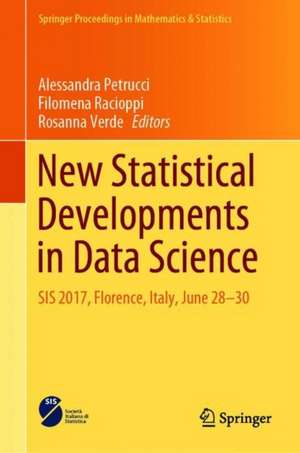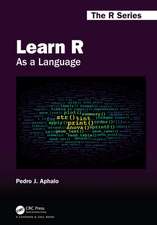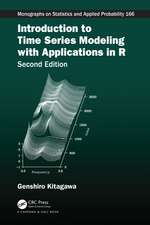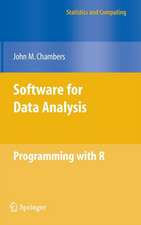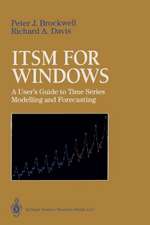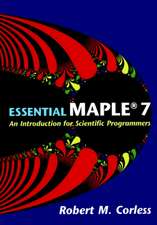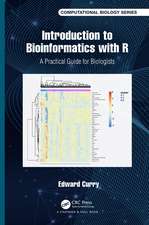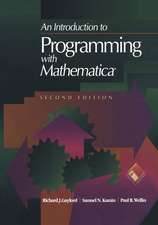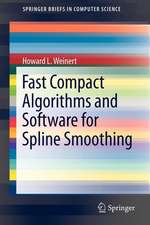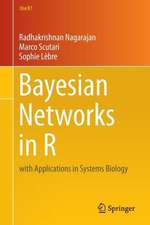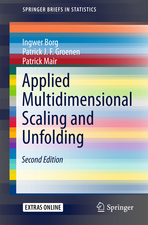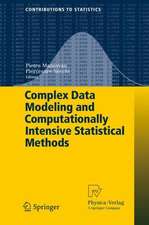New Statistical Developments in Data Science: SIS 2017, Florence, Italy, June 28-30: Springer Proceedings in Mathematics & Statistics, cartea 288
Editat de Alessandra Petrucci, Filomena Racioppi, Rosanna Verdeen Limba Engleză Hardback – 21 aug 2019
| Toate formatele și edițiile | Preț | Express |
|---|---|---|
| Paperback (1) | 648.36 lei 38-44 zile | |
| Springer International Publishing – 21 aug 2020 | 648.36 lei 38-44 zile | |
| Hardback (1) | 1016.01 lei 3-5 săpt. | |
| Springer International Publishing – 21 aug 2019 | 1016.01 lei 3-5 săpt. |
Din seria Springer Proceedings in Mathematics & Statistics
- 15%
 Preț: 642.03 lei
Preț: 642.03 lei - 15%
 Preț: 646.62 lei
Preț: 646.62 lei - 18%
 Preț: 727.31 lei
Preț: 727.31 lei - 24%
 Preț: 1236.85 lei
Preț: 1236.85 lei - 9%
 Preț: 624.24 lei
Preț: 624.24 lei - 18%
 Preț: 727.97 lei
Preț: 727.97 lei - 15%
 Preț: 656.43 lei
Preț: 656.43 lei - 18%
 Preț: 947.35 lei
Preț: 947.35 lei - 15%
 Preț: 646.62 lei
Preț: 646.62 lei - 18%
 Preț: 948.92 lei
Preț: 948.92 lei - 18%
 Preț: 1699.47 lei
Preț: 1699.47 lei - 18%
 Preț: 1120.18 lei
Preț: 1120.18 lei - 15%
 Preț: 644.95 lei
Preț: 644.95 lei - 18%
 Preț: 1233.83 lei
Preț: 1233.83 lei - 18%
 Preț: 1120.18 lei
Preț: 1120.18 lei - 18%
 Preț: 1033.37 lei
Preț: 1033.37 lei - 18%
 Preț: 948.92 lei
Preț: 948.92 lei - 18%
 Preț: 896.08 lei
Preț: 896.08 lei - 18%
 Preț: 1115.46 lei
Preț: 1115.46 lei - 18%
 Preț: 952.09 lei
Preț: 952.09 lei - 18%
 Preț: 1230.66 lei
Preț: 1230.66 lei - 15%
 Preț: 647.59 lei
Preț: 647.59 lei - 18%
 Preț: 1124.92 lei
Preț: 1124.92 lei - 20%
 Preț: 1630.95 lei
Preț: 1630.95 lei - 18%
 Preț: 1123.35 lei
Preț: 1123.35 lei - 18%
 Preț: 950.52 lei
Preț: 950.52 lei - 18%
 Preț: 947.35 lei
Preț: 947.35 lei - 18%
 Preț: 1003.70 lei
Preț: 1003.70 lei - 18%
 Preț: 956.81 lei
Preț: 956.81 lei - 18%
 Preț: 889.75 lei
Preț: 889.75 lei - 18%
 Preț: 1000.24 lei
Preț: 1000.24 lei - 18%
 Preț: 1122.56 lei
Preț: 1122.56 lei - 18%
 Preț: 1005.74 lei
Preț: 1005.74 lei - 18%
 Preț: 950.96 lei
Preț: 950.96 lei - 18%
 Preț: 1009.08 lei
Preț: 1009.08 lei - 18%
 Preț: 1008.91 lei
Preț: 1008.91 lei - 18%
 Preț: 947.35 lei
Preț: 947.35 lei - 18%
 Preț: 1113.89 lei
Preț: 1113.89 lei - 18%
 Preț: 1113.71 lei
Preț: 1113.71 lei - 18%
 Preț: 1400.35 lei
Preț: 1400.35 lei - 18%
 Preț: 969.44 lei
Preț: 969.44 lei - 18%
 Preț: 1401.93 lei
Preț: 1401.93 lei - 18%
 Preț: 948.92 lei
Preț: 948.92 lei - 18%
 Preț: 1392.46 lei
Preț: 1392.46 lei - 20%
 Preț: 878.68 lei
Preț: 878.68 lei - 20%
 Preț: 1002.91 lei
Preț: 1002.91 lei - 18%
 Preț: 1120.99 lei
Preț: 1120.99 lei - 18%
 Preț: 942.63 lei
Preț: 942.63 lei
Preț: 1016.01 lei
Preț vechi: 1239.04 lei
-18% Nou
Puncte Express: 1524
Preț estimativ în valută:
194.44€ • 211.13$ • 163.33£
194.44€ • 211.13$ • 163.33£
Carte disponibilă
Livrare economică 01-15 aprilie
Preluare comenzi: 021 569.72.76
Specificații
ISBN-13: 9783030211578
ISBN-10: 3030211576
Pagini: 472
Ilustrații: XIV, 479 p. 96 illus., 58 illus. in color.
Dimensiuni: 155 x 235 mm
Greutate: 0.91 kg
Ediția:1st ed. 2019
Editura: Springer International Publishing
Colecția Springer
Seria Springer Proceedings in Mathematics & Statistics
Locul publicării:Cham, Switzerland
ISBN-10: 3030211576
Pagini: 472
Ilustrații: XIV, 479 p. 96 illus., 58 illus. in color.
Dimensiuni: 155 x 235 mm
Greutate: 0.91 kg
Ediția:1st ed. 2019
Editura: Springer International Publishing
Colecția Springer
Seria Springer Proceedings in Mathematics & Statistics
Locul publicării:Cham, Switzerland
Cuprins
PART I – Complex data analytics: A. Balzanella et al., Monitoring the spatial correlation among functional data streams through Moran's Index.- O. Banouar and S. Raghay, User query enrichment for personalized access to data through ontologies using matrix completion method.- C. Drago, Clustering Communities using Interval K-Means.- F. Murtagh, Text Mining and Big Textual Data: Relevant Statistical Models.- G. Ragozini et al., A three-way data analysis approach for analyzing multiplex networks.- M. Ruggieri et al., Comparing FPCA based on conditional quantile functions and FPCA based on conditional mean function.- F. Santelli et al., Statistical archetypal analysis for cognitive categorization.- A. Vanacore and M. S. Pellegrino, Inferring rater agreement with ordinal classification.- PART II – Knowledge based methods: J. Koskinen et al., Bayesian analysis of ERG models for multilevel, multiplex, and multilayered networks with sampled or missing data.- C. Scricciolo, Bayesian Kantorovich Deconvolution in Finite Mixture Models.- A. Sottosanti et al., Discovering and Locating High-Energy Extra-Galactic\Sources by Bayesian Mixture Modelling.- F. Stefanini and G. Callegaro, Bayesian estimation of causal effects in carcinogenicity tests based upon CTA.- M. Subbiah et al., Performance Comparison of Heterogeneity Measures for count data models in Bayesian Perspective.- PART III – Sampling techniques for Big Data exploration: M. S. Andreano et al., Sampling and modelling issues using Big Data in now–casting.- M. D’Alò et al., Sample design for the integration of population census and social surveys.- C. De Vitiis et al., Sampling schemes using scanner data for the consumer price index.- S. Polettini and S. Arima, An investigation of Hierarchical and Empirical Bayesian small area predictors under measurement error.- E. Rocco, Indicators for monitoring the survey data quality when non-response or a convenience sample occurs.- PART IV – DataScience methods for social and population studies: P. Balduzzi et al., The propensity to leave the country of origin of young Europeans.- F. Bassi et al., New Insights on Student Evaluation of Teaching in Italy.- A. Bikauskaite and D. Buono, Eurostat methodological network: Skills mapping for a collaborative statistical office.- M. Costa, The evaluation of the inequality between population subgroups.- M. Manisera et al., Basketball analytics using spatial tracking data.- I. Morlini and M. Scorza, New fuzzy composite indicators for dyslexia.- A. Righi et al., Who tweets in Italian? Demographic characteristics of Twitter users.- PART V – Applying Data Science in economics and labour market: A. Agapitov et al., An approach to developing a scoring system for peer-to-peer (p2p) lending platform.- P. Mariani et al., What do employers look for when hiring new graduates? Answers from the Electus survey.- A. Mazza and A. Punzo, Modeling Household Income with Contaminated Unimodal Distributions.- G. Punzo et al., Endowments and rewards in the labour market: their role in changing wage inequality in Europe.- V. Voytsekhovska and O. Butzbach, The approach towards the analysis of wage distribution equality dynamics in Poland based on linear dependences.- PART VI – Mathematical statistics for Data Science: R. Fontana and F. Rapallo, Unions of Orthogonal Arrays and their aberrations via Hilbert bases.- F. Lagona, A copula-based hidden Markov model for toroidal time Series.- A. Lanteri et al., A biased Kaczmarz algorithm for clustered equations.- A. Lepore, Nearly Unbiased Probability Plots for Extreme Value Distributions.- V. Mameli et al., Estimating High-Dimensional Regression Models with Bootstrap group Penalties.
Notă biografică
Alessandra Petrucci is Professor of Social Statistics at the University of Florence, where she is Head of the Department of Statistics, Computer Science, and Applications and a member of the Academic Senate. Dr. Petrucci holds a PhD in Applied Statistics. Her research interests include methods for survey sampling, spatial statistics, environmental statistics, multivariate analysis, and teaching evaluation. She has published a considerable number of papers in national and international journals and has been a member of many research projects and scientific committees for several national and international conferences. Dr. Petrucci is an elected member of International Statistical Institute (ISI) and a fellow of the Italian Statistical Society (SIS). She is a member of the Centro Camilo Dagum, Tuscan Interuniversity Centre – Advanced Statistics for Equitable and Sustainable Development.
Filomena Racioppi is Associate Professor of Demography in the Department of Statistics at Sapienza University of Rome, where she is on the Board of the PhD program in Statistical Sciences. She is a member of the Italian Association for Population Studies, the Italian Statistical Society (SIS), the European Association for Population Studies (EAPS), and the International Union for Scientific Studies of Population (IUSSP). She has been a member and/or coordinator of several national and international research projects. She was executive editor of Genus from 1999 to 2009 and a member of the scientific advisory board for Population Research and Policy Review. Currently she is on the scientific board of Genus and serves as a reviewer for several demographic international journals. Dr. Racioppi’s research areas have included, among others, reproductive behaviors, applied and business demography, active ageing and age management, and gender issues during the life course.
Rosanna Verde is Professor of Statistics in the Department of Mathematicsand Physics at the University of Campania Luigi Vanvitelli, where she is coordinator of the Bachelor’s degree in Data Analytics. She is also on the Board of the PhD program in Social and Statistical Sciences at the University of Naples. Dr. Verde is a member of several international statistical associations and she is on the scientific board of SIS Group on Statistics and Data Science. She is associate editor of Statistical Methods & Application journal. She was an expert evaluator for the European Programme IST. She has coordinated various national and regional projects, and she has also participated in European projects. She was guest researcher and visiting professor at several foreign universities and research centres. Her main fields of research are: classification, symbolic data analysis, data stream analysis, and functional data analysis. She is a co-author of more than 100 papers in journals and in proceedings of international conferences.
Filomena Racioppi is Associate Professor of Demography in the Department of Statistics at Sapienza University of Rome, where she is on the Board of the PhD program in Statistical Sciences. She is a member of the Italian Association for Population Studies, the Italian Statistical Society (SIS), the European Association for Population Studies (EAPS), and the International Union for Scientific Studies of Population (IUSSP). She has been a member and/or coordinator of several national and international research projects. She was executive editor of Genus from 1999 to 2009 and a member of the scientific advisory board for Population Research and Policy Review. Currently she is on the scientific board of Genus and serves as a reviewer for several demographic international journals. Dr. Racioppi’s research areas have included, among others, reproductive behaviors, applied and business demography, active ageing and age management, and gender issues during the life course.
Rosanna Verde is Professor of Statistics in the Department of Mathematicsand Physics at the University of Campania Luigi Vanvitelli, where she is coordinator of the Bachelor’s degree in Data Analytics. She is also on the Board of the PhD program in Social and Statistical Sciences at the University of Naples. Dr. Verde is a member of several international statistical associations and she is on the scientific board of SIS Group on Statistics and Data Science. She is associate editor of Statistical Methods & Application journal. She was an expert evaluator for the European Programme IST. She has coordinated various national and regional projects, and she has also participated in European projects. She was guest researcher and visiting professor at several foreign universities and research centres. Her main fields of research are: classification, symbolic data analysis, data stream analysis, and functional data analysis. She is a co-author of more than 100 papers in journals and in proceedings of international conferences.
Textul de pe ultima copertă
This volume collects the extended versions of papers presented at the SIS Conference “Statistics and Data Science: new challenges, new generations”, held in Florence, Italy on June 28-30, 2017. Highlighting the central role of statistics and data analysis methods in the era of Data Science, the contributions offer an essential overview of the latest developments in various areas of statistics research. The 35 contributions have been divided into six parts, each of which focuses on a core area contributing to “Data Science”. The book covers topics including strong statistical methodologies, Bayesian approaches, applications in population and social studies, studies in economics and finance, techniques of sample design and mathematical statistics. Though the book is mainly intended for researchers interested in the latest frontiers of Statistics and Data Analysis, it also offers valuable supplementary material for students of the disciplines dealt with here.Lastly, it will help Statisticians and Data Scientists recognize their counterparts’ fundamental role.
Caracteristici
Highlights key statistical methods and recent contributions to data science Shows how Statistics and Data Analysis techniques can support business operations and provide essential information for decision-making Promotes the development of a statistical culture among students and researchers in the Information Age
